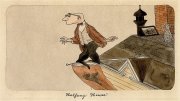Are grades inflated in the College--and does it matter? Debate over these questions is not new (see "Desperately Seeking Summa," May-June 1993, page 36). But the person who persists most ardently in addressing the issue--Harvey C. Mansfield Jr. '53 (summa cum laude), Ph.D. '61, Kenan professor of government--is pursuing a novel tack to raise it anew.
At the beginning of spring term, Mansfield announced that he would award students in Government 1061, "The History of Modern Political Philosophy," two marks: one reflecting his assessment of their work; and another, adjusted to the prevailing curve of grades handed out to undergraduates generally, to be forwarded to the registrar and recorded on their transcripts. The dual grading track, Mansfield said, would simultaneously enable students to enroll ("I was punishing the students who had the courage to take the course and risk a below-average grade"), while relieving the "strain on my conscience" from conforming to a prevailing system he considers biased. (In his thirty-fifth reunion report, Mansfield observed, "I confess I secretly enjoy my reputation as a tough grader.")
The initial reaction was as Mansfield intended. Registration surged to 110 students, he said--about double the number who took the course the last time he taught it. Grading of the required three papers and final examination will be done by four teaching fellows; to assure "consistency if not uniformity," Mansfield said, the teaching fellows will exchange bluebooks and confer, and he will, as well, "read the best bluebooks, the worst, and a sampling of those between."
Mansfield's new approach attracted plenty of attention, from the front pages of the Crimson and the Boston Globe to the Chronicle of Higher Education.
It also reopened old disputes. In light of data showing nearly three-quarters of undergraduate grades now falling into the range of B+ and above, Mansfield offered varying explanations for the phenomenon. As he sees it, one stems from a late-1960s degeneration from standard-setting into a feel-good culture prizing self esteem (on which, generally, see "The Thirty Years' War," September-October 1999, page 56). Reprising an argument he has made earlier, he also posited a faculty response to affirmative action, with professors of that period unwilling to give Cs to any newly arrived black students they considered average performers, and therefore moving their curve up for all students. (Others who weigh in suggest that grade inflation represents a hangover from the Vietnam War: willingness then to bend the rules to help students maintain draft deferments, and reluctance now to make it more difficult for a student to get into a top-tier professional or graduate school.)
Mansfield's affirmative-action thesis, unsurprisingly, provoked a reprise of the reaction it evoked in 1993. Deans denounced it in interviews and e-mails to the Crimson and Globe, saying there were no data to support his interpretation. Student letters to the Crimson divided between those who thought he was guilty of racism and those who agreed that grading had gone flabby and ought to be toned up. The Black Students' Association (BSA) organized a silent protest during one of Mansfield's lectures, and later met with him privately; afterward, BSA officers told the Crimson they were satisfied with the discussion. Following a separate meeting with the BSA, President Neil L. Rudenstine issued a statement declaring, "Nothing I have personally observed, and nothing I have read or heard, leads me to believe that grade inflation resulted from the enrollment of greater numbers of minority students."
The president, in fact, has "read and heard" about the subject in some depth, as he demonstrated at a Faculty of Arts and Sciences meeting last October, when Mansfield rose to ask him about the phenomenon of grade inflation generally. Rudenstine noted that the first observable grade inflation occurred from 1947 to 1949, when returning veterans of World War II swelled the College ranks--and graduated with a higher proportion of honors than any previous class. His experience in the years since, Rudenstine said, suggested that the trend of grades had been almost consistently upward. During his graduate studies at Harvard in the early 1960s, for instance, a grade of B was tantamount to failing out of the doctoral program. (Rudenstine cleared the hurdle, earning his Ph.D. in 1964, following Mansfield by three years.)
In this light, the president said, the important matters were whether Harvard grades could be properly interpreted within the College, and externally when Harvard students were compared to others, and--most importantly--whether students were in fact learning. On that point, he said, the evidence was good, and the shifting grade scale, throughout society, was relatively less important.





